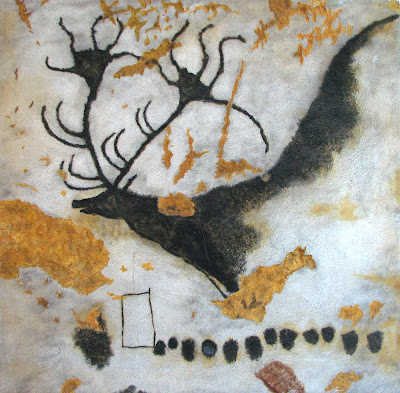When we paint, we speak to our present generation, but we’re also speaking to the future.
 |
|
Giant deer from the replica of Lascaux. |
The Irish elk was one of the largest deer that has ever lived. Its range was vast, across all of Eurasia from the Atlantic to Siberia, feeding on the same boreal woodlands that appeal to modern moose. Males had ridiculous showy racks. Some scientists think those racks were their downfall, because they made grazing too difficult.
What we know about them is limited mainly to fossils, and to the cave art of Lascaux (17,000 years old) and Chauvet Cave (30,000-35,000 years old). The interpretation of paleolithic art can be problematic, colored as it is by our own preconceptions. However, the animals themselves are straightforward, rendered with an eye to detail and description.
 |
|
Lion painting replica from Chauvet Cave, courtesy Brno museum Anthropos. |
At Lascaux, they include aurochs (the wild cattle that preceded our domestic cows) and a large animal that looks like a unicorn. There are big cats, horses, ibex, red deer and bison. At Chauvet Cave, the walls feature predators: cave lions, cave hyenas, leopards, bears, and rhinoceroses. Many of these species, like the Irish elk, have been extinct for millennia.
Fossils can be reconstructed, but they’re often just bones. They almost never give us a sense of musculature or color. Real-time paintings coupled with the fossil record give us a much more rounded view of these extinct animals.
Meanwhile, in Australia, scientists discovered a 17,300-year-old painting of a kangaroo. (Well, it’s a line drawing, and it’s been partially obscured, but it’s certainly a marsupial of some sort.) In Indonesia, there are cave paintings of a wild pig (45,000 years old) and a buffalo(44,000 years old). All of which tells us that there’s a whole world of undiscovered art underground, for those with the courage to go spelunking.
 |
|
Nakht and Family Fishing and Fowling, Tomb of Nakht, c. 1400-1390 BC, courtesy Metropolitan Museum of Art. |
The fruits, vegetables and game that we eat have been portrayed in art since the ancient Egyptians. These paintings tell us a lot about the evolution of the human diet, including when certain staples appeared in different parts of the world.
Dutch Golden Agepainters were focused on the abundance of their trade-based culture. That makes them a treasure-trove of information about food (and ships’ rigging, and window hardware, and almost every other aspect of 17th century European culture). Their traders were importing goods from all over the world, and the Dutch artists recorded it all. When we look at their paintings through the lens of art history, we tend to gloss over the taxonomy of what’s shown. However, the meticulous painting style that was prized in the Dutch Republic makes these paintings a scientific and historical resource.
Photography and our current excessive written history seem to have erased the need for paintings as documentation; that’s one reason for the explosion of abstraction in the 20th century. But, surely, that’s a short-sighted view. The nameless cave-painters at Chauvet Cave weren’t painting lions to preserve them for history—and yet they did. When we paint, we speak to our present generation, but we’re also speaking to the future. How that’s interpreted, and what it will mean, is beyond our current understanding.




